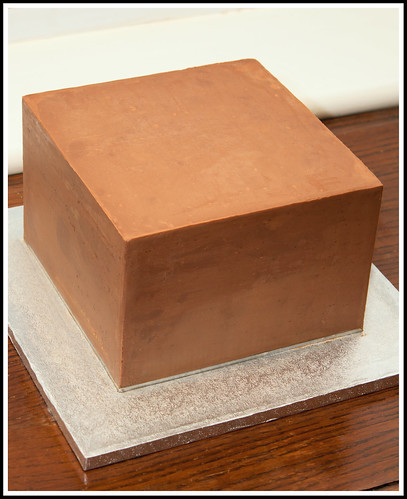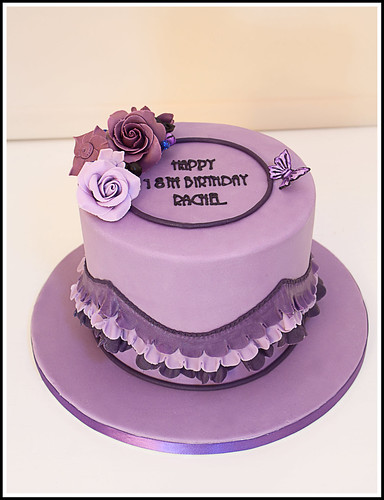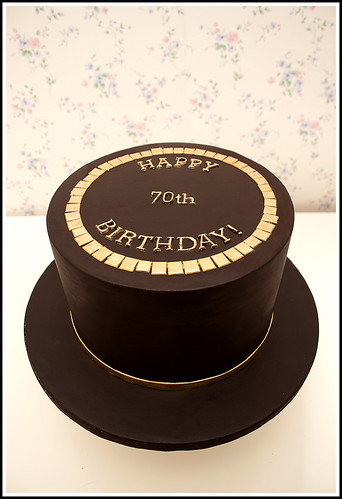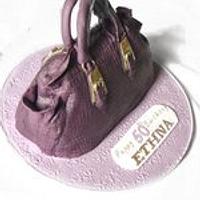Sharp Edges on Fondant Cakes
OK, so I posted some time back in one of the forum posts about how I achieve sharp edges on fondant, and while for the most part my technique is much the same, I am always learning how to do things better and I’ve changed some things. Here are some examples of cakes I’ve done using this method:



So anyway, this is how I go about getting sharp edges.
Basically my secret weapon as far as this technique goes is most definitely chocolate ganache – whether it be milk chocolate, dark chocolate or white chocolate. This can be achieved with an all butter buttercream like SMBC/IMBC, however it’s much easier with ganache.
To make ganache that is suitable for using underneath fondant you need only two ingredients, chocolate and cream! First things first, you need to use a specific cream. If you live in the UK, you need to use whipping cream (the one that comes in the green container), if you live in the states you need to use heavy/heavy whipping cream and if you live in Australia you need to use pure cream – basically you need something with around a 36% fat content, so whatever country you live in, just find a cream with that percentage of fat and you will be good to go.
Now onto the chocolate! When making dark chocolate ganache (which is by far the easiest to work with), it is best to use something around the 70% cocoa solid mark – I use 73% and it’s perfect. For milk chocolate I use one that has 35.6%. Milk and dark you kind of can’t go wrong if you stick with those percentages, however white chocolate is a whole different ball game. You need to find a white chocolate with as high a cocoa butter content as you can find, the higher the percentage, the firmer it will be. I switched to a more expensive white chocolate and regretted it, so it’s not all about cost! The brand I use has 30% cocoa butter.
So here are the recipes I use for my chocolate ganache – these are by weight and NEVER by volume:
Dark Chocolate Ganache: 2 parts chocolate to 1 part cream i.e. 1kg of chocolate to 500g of cream
White Chocolate Ganache: 3 parts chocolate to 1 part cream i.e. 900g of chocolate to 300g of cream
Milk Chocolate Ganache: 3 parts chocolate to 1 part cream i.e. 900g of chocolate to 300g of cream
To make chocolate ganache, I buy my chocolate in either Callets or Buttons as they are easier to melt and I put them into a plastic microwavable bowl and then cover with the cream. I then put it in the microwave on full power for 30 second blasts to start with until I can see it starting to melt, then I just do 15 second bursts. You have to be careful not to burn chocolate so just be careful. Once I have made my ganache, I cover it with clim film and let it cool down until it is at the consistency that I prefer. I prefer my ganache to be pretty soft, I prefer it to be softer than peanut butter, but only because my ganache goes firm so quickly (the joys of living in a cold climate).
For ganaching my cakes I use the upside down method – there are many ways to do this, if you google ‘upside down ganache’ or ‘upside down buttercream’ you will find several tutorials on this and you can use whichever one suits you best. This can be used for ganache or all butter, buttercream. The main things to make sure you have before you can cover with fondant is
1. A level cake – use a small spirit level to make sure
2. Straight sides – sloping sides are a no go!
3. Sharp edges on your ganache/buttercream
Here is a cake that I covered in ganache so you can see how sharp it already is before fondant:

Now, I used to keep my ganached cake refrigerated, however I just had too many problems with sweating (not me, the cakes!), so stopped it and realised there was never any need to (unless of course you have perishable filliings). I leave my cake overnight in a cool kitchen to firm up and dry. Then the next day I set about covering it. The first thing I do is brush my ganached cake with boiled water. You want enough water that you can cover every single inch of the cake (any dry spots can potentially turn into air pockets), but not too much water that the cake is soaking wet.
When it comes to fondant, I roll mines to around 2 or 3mm thick – if you are covering a dark chocolate ganache cake with white fondant, roll it to 3mm instead or you run the risk of seeing dark spots through the fondant. If your fondant is rolled to thickly, you won’t get super sharp edges, so this takes some practice.
So, cover your cake, trying to minimize air pockets – make sure that the fondant on the top and top edge of your cake is completely secure before moving down. Once you have the cake covered, take your fondant smoothers and try and smooth it as best you can. Here is where I used to pop the cake back in the fridge, but once again, I stopped that due to the sweating issue.
Now, once you’ve done this, you need to move onto the key part of achieving sharp edges and that is to use……ACETATE!!! Now I was a fool and opted to spend way too much money on 500 micron acetate, this is NOT necessary, especially if you have a hard time finding it. Any extra thick acetate will do and in Australia they use old X-Ray’s, so if you know the thickness of an X-Ray, then just find some aceate that is similar and that will do. I have my acetate cut to about 6” by 4” (that’s just a guess) – basically hand sized and I keep one sheet on the side of the cake (that sticks up past the top of the cake) and one on the top of the cake – the one on the top butts up against the one on the side and using firm pressure I slide the two round the cake together, making sure to keep them together. This action squeezes the fondant into the right angle you are creating with the acetate and forms that sharp edge. Just be careful to avoid digging the corners of the acetate into the fondant – I used a corner rounder to round the edges of mines so as to minimise this.
Some people are able to achieve the sharp edges using only fondant smoothers, however they are either magicians or I just don’t know how on earth it’s done! I’ve went from this level of sharpness with fondant smoothers (which at the time I thought was really sharp!!):

To this level of sharpness using acetate:

The acetate is also great for general smoothing too and I now find I couldn’t cover a cake without it!
Anyway, hope that has helped and if you have any questions, let me know :)
https://www.facebook.com/tortacouture | Perth, Scotland
49 Comments
That’s a really interesting point… I’ve always used two smoothers, might have to find some acetate now. Thanks for sharing x
Jayne, Cakes by Occasion, www.cakesbyoccasion.com
Thanks for sharing this precious informations.
You’re great!!!
I’m gona try this :)
Thanks a lot! :))))
O Meu Bolo, Site: http://omeubolo.wordpress.com/, My Facebook: http://www.facebook.com/omeubolo
Thank you so much for sharing this.
Melissa, http://thebakedequation.com/
Thank you very much for this. I am definitely going to try it out!
I am so envious of your sharp edges! Thank you for sharing this!
Rachel, Fondant Flinger New Orleans, LA www.facebook.com/fondantflinger
i feel like i have just found a box of treasure! ^^
thanks for sharing xo
Bito, Handmade with Love..just for you!, www.bunsintheoven.my
Fantastic tutorial. Very generous of you!
Thanks guys – I hope it’s been of some use :)
https://www.facebook.com/tortacouture | Perth, Scotland
Fabulous tutorial! Have to give this a go!
Benni - http://www.facebook.com/pages/Adventures-in-Caking/128896783863694
Thank you. I’m a new decorator and learn something new from my online friends every day.







